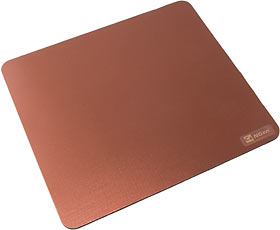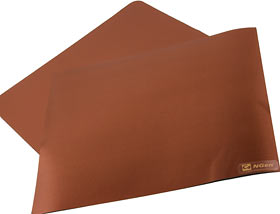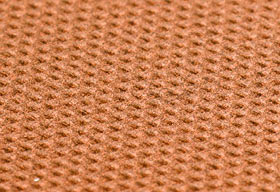
CS Hyde C4 NGen mouse mats
Date: 6-Jun-2008. Last modified 03-Dec-2011.
You'd think that fancy mouse mats would, by now, have developed about as far as they were ever going to go.
It's not as if there's a lot of selective pressure on them any more. Nowadays, there's not actually very much reason for ordinary computer users to bother with a mouse mat at all.
Back in 1999 when I reviewed the first hard-plastic mats, optical mice (or "mouses", if you prefer; I used to say "mouses", but I've surrendered now) were still rarities.
The early opticals worked well - I had one for my Amiga for years. But they were of the "Mouse Systems" type, which needed special printed mats. Later models would work fine on a photocopy of their mat, and haltingly on anything with a similar surface, like a halftone newspaper picture. But most surfaces were useless, especially for the earlier models, which needed the light portions of their special mat surface to be shiny and reflective.
For this reason, normal people back in those days were all still using optomechanical ("ball") mice. If you have that kind of mouse, it's a good idea to spend a few bucks on a mouse mat that offers good grip for the ball, and which won't transfer gunk to the ball's rollers too quickly.
Then modern all-surface optical mice arrived. They use a little camera peering out through the bottom of the mouse to tell how it's being moved, and they'll work on any surface that isn't translucent or reflective.
A plain desk top, a piece of paper, an old wetsuit-fabric mouse mat, your leg; pretty much anything's fine for a modern mouse.
But people still buy fancy mouse mats. And there are a lot to choose from.
The main reason for this, if we ignore the pose value of a Mat Authorised By Dennis or something, is that fancy mats have special slick surfaces. They make it easier for you to move the mouse fast, and they wear the mouse's slippery feet out more slowly.
Those surfaces are usually covered with little smooth bumps, so that the mouse feet can slide over the tops of the bumps and dust and other crud can fall into the valleys. If there aren't valleys, then any dust or hairs or whatever will grind around between the mouse feet and the mat; I've reviewed dead flat mats on previous occasions, and they've never worked well.
Once you've got the texture, though, there doesn't seem to be a lot more space for innovation in the mouse mat industry.
Which is where the CS Hyde Company comes in.
CS Hyde are in the business of "High Performance Fabrics, Tapes and Belting". They sell all sorts of threads and tapes and sheets and films, and it presumably occurred to them one day that something in their warehouse was probably crying out to be the big new thing in fancy mouse mats.
That something became the "C4" line of mats. They're all based around a woven substrate with a PTFE ("Teflon") coating. That coating can be had on a traditional fairly-flexible mouse mat with a rubber backing, or in a thin self-adhesive version that you can stick to your desk or any other object (to, for instance, resurface a hard plastic mat), or in a similarly thin version with non-adhesive backing. That last one's rather like the granddaddy of all fancy mouse mats, 3M's Precise Mousing Surface, which has a lot of friction by modern standards but is still worth trying. You can even get C4 mat material in custom shapes and sizes.
All of the mats cost, if anything, a bit less than most competing fancy-mats.
This is the "Medium" size of "C4 NGen" mat, the standard type with eighth-inch rubber backing. It's 8.5 by 9.5 inches, which is more than big enough for most gamers, and it costs only $US13.45 direct from CS Hyde, plus $US4.50 postage within the USA (international customers have to contact CS Hyde for a shipping quote).
There's also a small C4, 8.5 by seven inches, for $US11.40 plus shipping, and a large model that's 16 by 10 inches for $US15.35 plus shipping. True cheapskates could cut the large pad into two pads each about the size of the medium. Hard-core cheapskates may find CS Hyde's scratch and wrinkle department interesting.
CS Hyde also sent me the 8.5-by-10-inch "Landing Strip" version of the "C4 NGen 04" mat, here lying on top of the C4 mat.
("Landing Strip" is the smallest size in this line of mats. You can also get, in increasing order of size, "Large", "Super", "Monster" and "Giant". Take that, Starbucks!)
The NGen 04 mats are the ones with the thin non-adhesive backing. If you want a mouse mat with almost no height at all, and don't mind being a bit careful to make sure it doesn't get folded and damaged (a bit of tape to hold down the edges will do the trick), they're the ones for you.
The "Landing Strip" size of NGen 04 will only cost you $US10.49 plus delivery. And you can get the NGen 04 material in sizes up to the "Giant" 20 by 36 inches - which is more than half of an average desk. It's $US33.
All of the NGen mats have the same surface, which looks quite unlike any other mouse mat.
Under diffuse light it's an uninteresting brown. Magnify it...
...and you can see the texture.
The woven pattern under the PTFE means there's about one bump per millimetre vertically, and about 1.2 bumps per millimetre horizontally.
When light reflects off the NGen surface, though, it takes on a metallic bronze appearance.
You can clearly see the bumps with the naked eye then. In close-up they become quite beautiful:
(There's a 1600-pixel-wide version of that image here.)
You won't see this effect without magnification, though. Normally, the NGen surface just has a sort of half-polished bronze appearance, as shown in this promo pic.
Using it
The NGen surface, when brand new, is about as slick as any mouse mat I've ever used - and I'm including hard plastic mats with a spritz of silicone spray on them, too. If you're new to low-friction mouse mats then you're likely to find the experience a bit weird, but it's easy to get used to it. As long as you've got reasonably steady hands, I think a slick mat is the way to go for all sorts of mouse-intensive tasks - games, Photoshoppery, you name it.
I then annoyed the CS Hyde people by putting the rubber-backed C4 NGen on my desk, and then delaying this review until I'd been using the thing long enough to be able to tell if it seemed to be wearing out quickly.
Every new super-mat always feels slicker than greased weasel guts when it's brand new, after all. Every now and then, though, that slickness doesn't turn out to last, as in the Great Polystyrene Mouse Mat Scandal Of 2003.
The Unique Selling Point for these mats is the slick PTFE surface. PTFE itself is a very tough material, but PTFE coated onto a woven substrate isn't, necessarily. It'd obviously be no good if the surface scratched off after a couple of months of normal use.
Well, I've given this C4 NGen more than six months of heavy use, now. CS Hyde have probably despaired of ever getting a review out of me.
But the surface of the mat is just fine.
If I look at the surface under magnification I can see little scratches, and there now seems to be a slight difference in slickness between the well-used middle of the mat and the hardly-touched edges. But it's really barely detectable.
This despite the best efforts of one cat who insists on sitting on my mouse like a penguin keeping its egg warm...
...(here depicted with my previous mouse mat).
He's traversed, and sat upon, this mat several times, and the more noticeable scratches are probably down to him.
I have been taking care to keep grit off the mat. If you let abrasive dirt or dust sit on your mouse mat, it'll scratch up both the mat and the feet of your mouse quite quickly. But this goes for any mat, not just the NGens.
I doubt the NGen mats are quite as durable as a standard polypropylene hard mat. But they start out slicker than standard plastic mats, so it's quite possible that they'll still be slicker even two or three years down the line. They certainly don't seem likely to wear out a lot faster.
Because all of the NGen mats are soft and floppy, they're obviously more susceptible to damage than their hard-plastic competition. If you drop pointy things on them, if your pet uses them as a launch- or landing-pad, or if you just crease them, you'll hurt them. So, you know, try not to do those things.
Folding is not much of a risk for the rubber-backed C4 mats, though; they're only slightly more foldable than the cheap kind of thin rubber-backed mat, that has a stiff plastic top surface. The most crease-proof floppy mats are the type with a rubber backing and a cloth surface - like this - but I don't think fold damage will be a problem with any of the CS Hyde mats except for the super-thin non-adhesive NGen 04s. Those, as I said, will probably benefit from a bit of tape around their edges.
A bit of light pocket-knife experimentation on a corner of the C4 NGen showed that it's not at all difficult to dent this thicker rubber-backed mat.
Fortunately, though, even if you drop a screwdriver or something on your mouse mat and put a really big and obvious dent in it, it'll still probably work fine. You shouldn't expect a C4 mat to still be usable if you plink at it with a BB gun for an afternoon, but the feet on your mouse are big enough to glide over small dents, and your mouse's optical pickup shouldn't have any trouble with them either.
And, for the record, the feet of my mouse accumulated schmutz at a normal rate while I used the C4 mat. There'd be a little bit of caked-on crud on one or two feet every few days; easy enough to wipe off. Bumpy-surfaced mouse mats create a complex gunk-relocation situation, in which the gunk accumulates in the valleys between the bumps, and what gunk makes it onto the mouse feet is scraped off and moved around by the bumps.
Nothing compares with the wonderful dark grey doughnuts that built up on the rollers of optomechanical mice back in the day, but if you want to try for the nearest modern equivalent, I suggest you use your mouse on a shiny varnished desk-top. Then, the surface of the desk will help to compact the crud onto the mouse feet, sometimes with quite impressive results.
Extras
The mouse mat is only responsible for half of the friction you feel when you're pushing a mouse around. The other half is down to the state of the mouse's feet, which won't be very slick any more if the mouse is very old or has been used on a less forgiving surface, like the uncovered top of a desk.
For this reason, pretty much every mouse-mat company sells self-adhesive PTFE tape and/or dots, which you stick over worn-out mouse feet to bring the slickness back. CS Hyde are no exception; they've got discs and dots and tape and "skates" (short lengths of tape). They sent me some for review, and they seem to work as well as anybody else's version, which is pretty much what you'd expect since PTFE is PTFE, no matter who you buy it from.
There is a difference, though; price. Most mouse mat companies buy stick-on Teflon tape and dots from a company that makes them, cut them down into little eight-dot or five-inch packages, and sell it at a spectacular mark-up. CS Hyde, however, are a company that makes this sort of thing, so they'll only charge you four US bucks (plus delivery) for thirty 0.75-inch Teflon discs - or six bucks fifty for 139 of them.
All this and more awaits your attention on their Accessories page.
Overall
I wasn't expecting the C4 mat to last as well as a hard plastic mat, but it looks as if it really will. It's staying nice and slick, too; your typical polypropylene mat is starting to look a bit sanded-down after half a year, but the C4 mat seems to hardly have worn at all.
If the C4 mats cost twice as much as the competition, I wouldn't be able to recommend them. Yes, they feel nice and look interesting and are durable, but they don't Revolutionise the Mousing Paradigm or anything.
The CS Hyde mats actually, however, cost the same or slightly less than the competition. And they're available in a plethora of sizes, and you can pick up some cut-price sticky Teflon dots while you're at it, to re-shoe your worn old Explorer 3.
Given the price, and given the durability I've spent these several months testing, the C4 mats get a Recommended from me.
Review C4 mouse mats kindly provided by CS Hyde Company.






